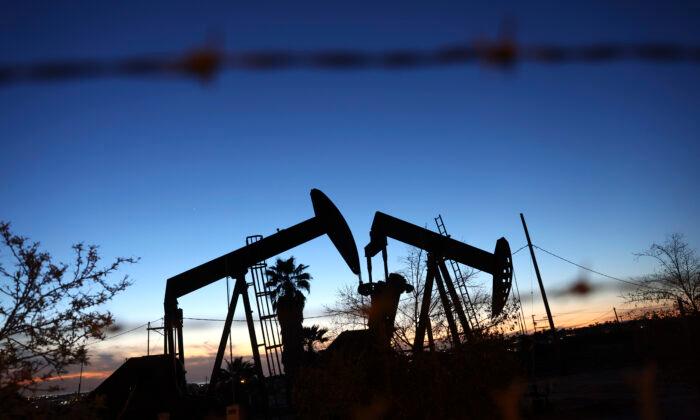U.S. crude oil prices headed toward $90 a barrel in the middle of the trading week after three major industry reports verified supply deficit concerns.
West Texas Intermediate (WTI) crude futures firmed above $89 per barrel on Sept. 13 on the New York Mercantile Exchange, adding to their year-to-date gain of nearly 11 percent. Over the last three months, the U.S. benchmark has soared about 30 percent.
Brent, the international benchmark for oil prices, topped $92 per barrel on London’s ICE Futures exchange. The Brent contract is also up more than 7 percent so far this year, fueled by a 25 percent rally since June.
What the Reports Say
In its Short-Term Energy Outlook (STEO), the EIA revised its forecasts for crude prices higher. Researchers expect Brent crude prices to average $93 a barrel in the fourth quarter, up from the previous estimate of $86.The oil production cuts from OPEC+ members, including Saudi Arabia’s extension of voluntary output cuts for the rest of 2023, supported the federal agency’s forecast for sliding stockpiles. However, it anticipates that global liquid fuel production will rise by 1.7 million barrels per day (bpd) in 2024, driven by non-OPEC producers, including the United States, Canada, Brazil, and Guyana.
“A decline in global oil inventories in the coming months supports the Brent price in our forecast,” the EIA wrote. “The price eases to an average of $87/b by the second half of 2024 because we expect global oil inventories to rise during that period.”
Russia also announced that it would extend its production and export reductions heading into 2024.
According to the IEA, the crude output cuts will result in a significant market deficit in the October-to-December period.
The IEA noted that the paucity of cuts at the beginning of next year could transition global energy markets to a surplus.
“However, oil stocks will be at uncomfortably low levels, increasing the risk of another surge in volatility that would be in the interest of neither producers nor consumers, given the fragile economic environment,” the OMR stated.
In August, total OPEC production was 27.96 million barrels a day, up slightly from the 27.87 million bpd in July.
OPEC’s oil forecasts were mostly unchanged, projecting an increase in worldwide crude demand in 2023 and 2024 as a result of stronger-than-expected conditions in major economies.
The Monthly Oil Market Report (MOMR) anticipates oil consumption will rise by 2.25 million bpd next year. The cartel added that OPEC production swelled by 113,000 bpd in August, to 27.45 million bpd, mostly because of larger output by Iran.
“The ongoing global economic growth is forecast to drive oil demand, especially given the recovery in tourism, air travel, and steady driving mobility,” OPEC said in the report. “Pre-COVID-19 levels of total global oil demand will be surpassed in 2023.”
Even with Western sanctions imposed on Tehran, the energy producer forecasts that production is expected to reach 3.4 million bpd by the end of September, with exports climbing above 2 million bpd. Iran is now the third-largest OPEC producer after Saudi Arabia turned down the taps.
OPEC maintained its global economic growth forecast of 2.7 percent this year and 2.6 percent for 2024.
US Oil Supplies
In its weekly storage report, the EIA reported that crude oil inventories surged by 3.954 million barrels for the week ended Sept. 8, up from the previous week’s drawdown of 6.307 million barrels. The market had penciled in a withdrawal of 1.912 million barrels.Gasoline inventories advanced by 5.56 million barrels, heating oil stockpiles rose 113,000 barrels, and distillate supplies climbed by 3.931 million barrels. Domestic production has been robust over the last month, with output coming in at 12.8 million bpd last week.
Despite five consecutive weeks of rising emergency stockpiles in the Strategic Petroleum Reserve (SPR), total crude inventories slumped below 767 million barrels, the lowest level since March 1985.
With the country consuming approximately 20 million barrels per day, the United States maintains about 40 days’ worth of supply.
Looking ahead, the Biden administration will likely hit the pause button on its efforts to replenish the SPR and potentially be less strict in enforcing sanctions against Iran, say ING analysts.
“Higher prices are likely to lead to increased political pressure, particularly given that there are elections in a number of countries next year, including key oil consumers, the U.S. and India,” they wrote in a research note. “It may be difficult for the U.S. government to allow further releases from its strategic petroleum reserves (SPR), but we are likely to see the government taking a pause in refilling the SPR after the large releases seen last year. In addition to this, the U.S. is likely to be less strict in enforcing sanctions against Iran. Already, in recent months this appears to be the case.”
The significant uptick in crude prices has added to motorists’ pain at the pump. According to the American Automobile Association (AAA), the national average for a gallon of gasoline is about $3.85, up nearly 20 percent year to date.







